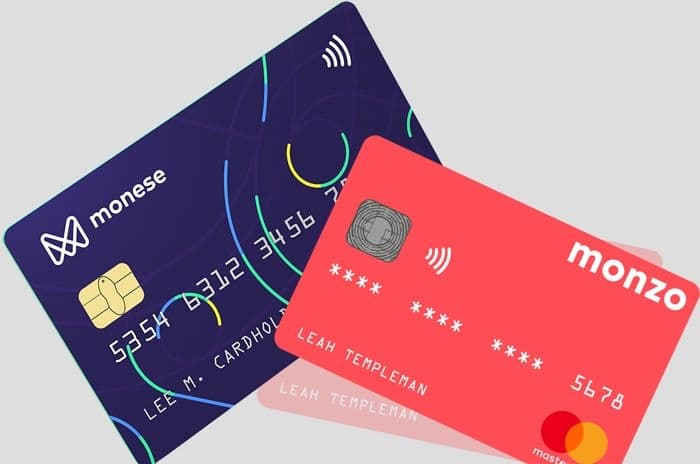The rise of so called 'challenger banks' has brought us new ways to manage our money. Two of the biggest names in the sector are Monzo and Monese, both promising slick apps, better overseas spending and interesting features to tempt us away from the high street.
But which is really worth our time, and who offers better value and protection for our hard earned cash? Let's find out.

Monzo vs Monese at a glance
Both services have a lot of similarities, but there are some key differences to take into account too. Here are the bare statistics to kick off our comparison of these two services:
Monzo |
Monese |
|
|---|---|---|
| Set up fees | Free | £4.95 for debit card |
| Time to get a debit card | 2 - 7 working days | 3 - 5 working days |
| Overdraft facility | Yes, chargeable | None |
| Use of ATMs | Free | £1 per withdrawal |
| Sending money | Via bank transfer or instant credit to another Monzo account | Via bank transfer or fast credit (not necessarily instant) to another Monese account |
| Direct debits | Automatically migrated (via CASS) if required, can see on homepage | Manually migrated, view in account, cancel with one click |
| Topping up | Bank transfer, standing order or have your salary paid in | Bank transfer, salary payments or top up at Post Office or Paypoint location (charges) |
| Interest | None | None |
| Savings | Set a savings goal and manage from account | No savings feature |
| Withdrawals overseas | Withdraw up to £200 every 30 days free, 3% fee thereafter | €1 per withdrawal |
| Withdrawal limit | None | £300 per day |
| Foreign transaction fees | None | 2% on card spend or ATM withdrawal |
On the face of it, Monzo looks to have the upper hand so far. However, this absolutely depends on what you plan to use your account for, how much you plan to use it and how you handle your money.
It should also be pointed out that we're comparing the free Monzo account with the, also free, starter account from Monese. For £4.95 a month, the Monese account can be upgraded to a 'plus' account, which will eliminate a lot of the fees and charges specified in the table above.
Longevity and customer base
Monzo has been around since 2015. In that time, it's amassed a following of more than 800,000 customers.
Monese has also been in business since 2015, although it didn't really start emerging as a serious player until the end of 2016. So far, they have more than 500,000 customers.
Set up
Monzo is super easy to set up, requiring basic information to be entered into the app along with a short selfie video for ID verification. Once finished, you'll need to wait for your debit card to arrive in the post which will allow you to finish setting up the account.
Another plus point for Monzo is that it's part of the Current Account Switching Service (CASS) which means you can migrate all your direct debits and bills over automatically. This can save a whole lot of time when you're moving bank accounts. Find out more in our guide here.
The downside of Monzo is that it's only available to UK residents, which excludes anyone currently abroad or without a fixed address from the service.
Monese is arguably the easiest bank account to set up available. They boast of their 'instant set up' account, which in reality takes around five minutes... so not exactly instant, but certainly pretty darn fast!
You'll need to wait for your debit card to spend in shops or to use ATMs but can start using Monese to send and receive money as soon as you've finished the set up process.
The biggest plus point for Monese is that you don't need to have a UK address in order to open an account. Any EEA address can be used, and if you've got no proof of address they have clever authentication methods in play, including taking a selfie video or making a FaceTime call to their team.
Protection
In terms of fraud prevention, both providers have built in some protection to their services. Both send real time notifications to your phone via the app whenever a spend is detected. Both also allow you to block your card via the app should you spot a strange transaction or realise you've misplaced your card.
Monzo is a fully licensed bank, with deposits covered by the Financial Services Compensation Scheme (FSCS) for up to £85,000 per customer. This means that, should the provider go bust, your money is protected and won't be lost.
Monese is not part of the FSCS scheme. Instead, they say that your money is ringfenced and not used or invested by them. This means it's kept completely separate and, should the company go bust, all your money will come back to you.
As with any financial provider, both banks must refund you your money if you are the victim of a fraud, so long as its not down to carelessness on your part. Because they operate in the UK, they are both regulated by the Financial Conduct Authority (FCA).
Functionality
As far as using these banks goes, they are both pretty straightforward. Both offer a debit card from Mastercard, offering easy spending at the majority of retailers worldwide. Both are able to handle direct debits, standing orders and to receive your salary, so offer an effective replacement for a traditional bank account.
However, there are some features that differ between the two
We love the spending tracker built into Monzo. It's got a breakdown of what you've spent, where and on what items, helping you manage your money better by building up a picture of where your cash is going.
Each time your card is used, the app sends a notification; great as an early warning system if your card was to go missing. You can even set spending goals where the app will let you know if you're running your balance down too fast.
Unlike Monese, Monzo does have an overdraft facility, which can be switched on and off within the app. Users are charged nothing for the first £20, and then 50p per day thereafter. While this may be attractive to some, staying overdrawn for a month would end up costing £15, so may not be such a great feature if you're not brilliant at managing your cash.
On the other hand, Monese also has some amazing features too, such as the 'Instabalance' feature. This basically leaves a real time view of your account balance lurking in the notifications tray of your smartphone, so you can simply glance at it whenever you need to know how much you have left to spend.
We also like the balance graph in the app, which provides a visual representation of spending habits. This is a great way to get to grips with where your money goes, as well as to start working towards spending and saving goals as a result.
Spending abroad
One of the biggest pluses with these new types of bank accounts is the functionality they add for the frequent traveller, digital nomad or location independent person. In fact, both brands trade heavily on their ability to fill a niche that high street banks charge a great deal for.
Monzo is the better option for spending overseas. Any spending on the card is fee free and unlimited. However, you can only withdraw up to £200 in cash from foreign ATMs each month, after which time there's a 3% charge.
However, the exchange rate at Monese can be better, as it tracks the base interbank rate. They also charge a low 2% to transfer money abroad, which drops to 0.5% with the Plus account and to 0% with the Premium (£14.95 a month) account.
Our verdict
Both providers have their pros and cons, and the winner out of Monzo vs Monese will depend on who you are and what you want to do.
Monzo is a genuine contender for your regular bank. Most users so far have been a little nervous to move all their banking activity to this new provider, but this may change in the future. Monzo have set themselves up to be capable of handing all your banking needs, and as a UK only provider, are squarely aiming themselves at being a replacement for your current account provider.
Monese, on the other hand, have a slightly different target audience. Developed by an Estonian who struggled to open a UK bank account upon arrival in the country, Monese is designed to cater to a more international market.
For those who are either coming to the UK from abroad, or are from the UK and working abroad, Monese fills a gap in the market for an accessible, functional UK current account with no credit check or address verification required. Monese is more generous on the foreign transaction fronts, particularly if you upgrade from the standard account.
In a nutshell, if you're looking for a replacement for your UK current account, Monzo offers the better deal. But, if you're travelling a lot, are coming to the UK from the EEA or have no credit address history, Monese is a feasible option.
You can read more about Monzo in our hands on review here, and about Monese in our guide here. If you're thinking of switching your current account, you can find out about the benefits available here, and discover what to check here.









Comments